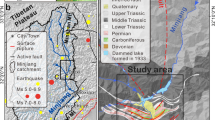Abstract
—Western Hokkaido, the northernmost island of Japan, is prone to landsliding due to geologic, geomorphologic and climatic change. From 1985 to 1997, many rapid large-scale landslides occurred in western Hokkaido, several of which are reviewed in this paper. The 1988 Kamaya Slide, the 1991 Tachimachi-misaki Slide (which was preceded by the 1985 Orito Slide), the 1993 Okushiri-Port Slide, and the 1994 Motochi Earthflow are described. Finally, two sea-cliff rockfalls are also described.¶The Okushiri-port Slide and the Toyohama Tunnel Rockfall claimed 29 and 20 lives, respectively. Except for the Okushiri-port Slide, which was induced by Hokkaido Nansei-oki Earthquake, most of the slides and rockfalls were probably related to geological structures, such as gentle-dipping strata interbedded with clayey tuffs and were triggered by long-duration and/or high precipitation, causing increased groundwater levels and/or high water pressures.
Similar content being viewed by others
Author information
Authors and Affiliations
Additional information
Received June 20, 1998, revised November 24, 1998, accepted May 16, 1999
Rights and permissions
About this article
Cite this article
Yamagishi, H. Recent Landslides in Western Hokkaido, Japan . Pure appl. geophys. 157, 1115–1134 (2000). https://doi.org/10.1007/s000240050020
Issue Date:
DOI: https://doi.org/10.1007/s000240050020




